The Ultimate Founder-Led LinkedIn Guide
35+ LinkedIn post templates & 5 top SaaS founder brands
Hey - it’s Alex, this time together with Ivan Peric!
Today we cover:
1️⃣ 5 SaaS founders with stunning LinkedIn personal branding
2️⃣ The 7 steps to build your LinkedIn Thought Leadership content strategy
3️⃣ 10 actionable tactics to get attention on LinkedIn from your target audience
Bonus: 35+ LinkedIn post templates ready-to-use for you
In case you missed the last 3 episodes:
✅ 9 tactics to get your first 50 SaaS customers in 2025
✅ The 21 GTM Channel to grow your SaaS
✅ How to create your high-converting sales deck (free template)
If you’re new to the newsletter: I share bi-weekly actionable SaaS GTM strategies and tactics that will help you grow your B2B SaaS business from €0 to €1 million ARR 🚀
If you enjoyed this post, share it with a friend to get my 100+ actionable SaaS growth tactics for free 🥁
👇This guide might be too long for your email inbox. So read the full guide here 👇
The 3 Pillars of a Successful LinkedIn Content Ecosystem
The best-performing companies on LinkedIn rely on a multidimensional content strategy based on three key pillars:
Founder-Led Content – The founder (or central executive) is positioned as the face of the brand.
Employee-Led Content – Employees contribute to the narrative by sharing their insights.
Company Content – The corporate page supports strategic goals through targeted content, such as case studies and company news.
Many companies invest heavily in their corporate LinkedIn page, only to be disappointed by low engagement.
The reason is simple: 👉 People buy from people.
Even TikTok’s CEO takes time to address trending industry topics. In today’s social media landscape, audiences crave authenticity, transparency, and behind-the-scenes insights. The best companies embrace this shift and put their leadership team front and center.
What is Founder-Led LinkedIn?
A Founder-Led LinkedIn strategy is a content and engagement approach in which the company’s founder (or co-founder) actively builds personal authority, thought leadership, and brand visibility rather than relying solely on the company’s LinkedIn page.
Personal Profiles > Company Profiles
Why Founder Brands on LinkedIn are Crucial
People engage with people, not logos.
By leveraging their personal brand, founders can:
✅ attract inbound opportunities,
✅ increase brand awareness,
✅ build trust,
✅ and position themselves as industry leaders.
This means LinkedIn thought leadership enables founders to build trust (at scale) - especially important for early-stage founders who usually lack social proof and brand trust at the beginning of their journey.
But let’s take a closer look at the advantages of LinkedIn thought leadership for SaaS companies:
1️⃣ Positioning in the Niche
To be seen as an expert in your market segment, you need to establish a clear and strategic position in your prospects' minds.
2️⃣ Shortened Sales Cycles
A strong LinkedIn presence builds trust long before your sales team reaches out.
3️⃣ Stronger Customer Retention
Existing customers want to see you stay relevant and provide continuous value.
4️⃣ Inbound Leads
With the right content strategy, potential customers will reach out to you.
5️⃣ Partnerships & PR
Increased visibility leads to strategic collaborations and media opportunities.
6️⃣ Owning Your Audience
Building your audience reduces dependency on paid ads and shifting platform algorithms.
5 founders driving pipeline and revenue for their SaaS with LinkedIn
Let’s give you some examples of SaaS founders with great personal branding.
Adam Robinson
Adam Robinson is most probably one of the top examples of 2024. He got 21 million views on LinkedIn, growing his company to §$4M ARR. But he also spent 65% of his time on content work.
LinkedIn Post example
Enzo Avigo
LinkedIn Post example
He’s what we consider ‘building in public’ and sharing transparently his journey.
But he also knows how to ‘entertain’ the audience. His most successful posts are some very funny GIFs (but always greatly aligned with his overall positioning ‘product analytics’).
We asked Enzo about his best tips:
Tyler Denk
LinkedIn Post example
But let’s also look at some ‘smaller’ accounts and see how they are doing it.👇
Eva Johanna Egg
LinkedIn Post example
We asked Eva Johanna about her best tips:
Arnaud Belinga
LinkedIn Post example
Sharing product updates of his simple Sales CRM breakcold👇
or helping guides, workflows, or cheatsheets 👇
We asked Arnaud about his best tips:
These founders don’t just post—they strategically engage and build ecosystems around their expertise.
👉 Hit ‘reply’ and share your best founder profiles.
#1 Building the Foundations for your LinkedIn Content Strategy in 7 Steps
By now we know:
what founder-led LinkedIn marketing is
why it’s important
and great founders with strong personal branding
In the upcoming sections, we share with you step-by-step how you can become a strong LinkedIn brand yourself.
Product Marketing: The Foundation of Your LinkedIn Strategy
A LinkedIn presence isn’t just about content—it’s a business decision with clear goals. Your product or service should directly influence your content themes.
So, before diving into LinkedIn content creation, get clarity on your Go-to-market (GTM) foundations:
Ideal Customer Profile (ICP) & Jobs-To-Be-Done (JTBD)
If you haven’t clearly defined these yet, now is the time.
Ask yourself:
What industry and product category does your solution belong to?
What usecase(s) do I need your product for? What core problem do you solve for your customers?
Who are your main customers and why?
What key KPIs does your product influence?
What are the benefits and results for your customers using your product?
How long does it typically take for your customers to see measurable results?
What is your most concise one-sentence pitch or value proposition?
Your answers shape how you position yourself and your product, and what content resonates best with your audience.
But let’s go through each of these step-by-step now.
Step 1: Ideal Customer Profile (ICP) & Jobs to be Done
A clearly defined ICP allows you to create highly relevant content and meaningful engagement - is the foundation that helps you in many ways on LinkedIn
Depending on your Go-To-Market (GTM) phase, you may have multiple ICPs, but the goal is to prioritize one segment for focus.
Remember, a great ICP consists of:
1️⃣ Your Ideal Company (Firmographics)
2️⃣ Your Ideal Personas (User/Champion & Decision Maker)
3️⃣ Your Anti ICP
Feel free to use my Ideal Customer Profile template for this 👇.
To write content that resonates with your ICP, clearly define your:
✅ market's pain points/challenges
✅ and your ICP's Jobs-To-Be-Done (JTBD)
✅ ’a day in the life of your customer’ including activities, responsibilities & metrics
👉 Example: Product Description for a Project Management Tool
Job Titles/Roles:
Project Managers
Product Managers
Team Leads
Agile Coaches
Operations Managers
Company Size and Type:
Mid-sized to large enterprises (50-500 employees).
Tech startups, digital agencies, and IT consulting firms.
Industry Verticals:
Software Development
IT Consulting
Digital Agencies
JTBD
As a project manager, I want to…
Easily track project progress so that I can ensure deadlines are met.
Automate repetitive tasks to free up time for strategic planning.
Get real-time updates from my team so I can quickly resolve blockers.
Key Challenges/ Pain Points They Face:
Lack of visibility into project progress—teams struggle to track deliverables and deadlines.
Inefficient communication between teams—messages get lost across multiple platforms.
Task overload and misalignment—team members get overwhelmed with unclear priorities.
Difficulty managing remote and hybrid teams—lack of centralized collaboration.
Bottlenecks in approval processes—delays due to slow decision-making.
💡 Tip: To identify your pain points in the market, a few ways to consider:
Qualitative JTBD interviews with your ICP
Call Recordings of your Discovery & Demo Calls
Reading review platforms like G2 & Capterra
Using AI-powered tools like Synthetic Users
Use custom research prompts
Step 2: Positioning & Messaging (Differentiation in the Market)
Why should customers choose you over competitors? Your market positioning determines your success on LinkedIn.
We recommend following 4 steps.
Step 1: Understand the current way of doing things (Status quo)
Step 2: Understand alternative options
Step 3: Choose your product category or use case
You as a founder need to make a crucial decision in terms of positioning.
Usecase Positioning vs. Product Category Positioning
In a nutshell, do this:
✅ Product Category positioning: if you’re building a product in an established market
→ Good indicator: you will find a category on G2, Capterra, etc. and there’s existing search demand on Google & co.
✅ Usecase positioning: you’re building a product in a rather new market (blue ocean); no established product category has been built yet.
→ Good indicator: No product category on G2, Capterra, etc.
Step 4: Add your unique differentiation (positioning angle)
Now you need to add 1 or more of the 6 SaaS positioning options.
1️⃣ Niche down
Finding an (underserved) segment of the market and building the best tool for them.
Most of the time it's vertical-specific tools.
Examples: Resource management software for the public sector (locaboo.com) or banking account for freelancers (kontist.com)
2️⃣ Low-cost player
Mostly in a more crowded market when market leaders increase their prices (a lot), you have the chance to build a low-cost version of it.
Best for PLG products.
Examples: Breakcold or Clickup - Cheaper alternatives to market leaders like Salesforce or Asana
3️⃣ Premium-player
Serve clients that need more human touch (customer service, sales demos...). You can position yourself as the premium player. Mostly more connected to the enterprise segment.
Examples: Salesforce or Adobe Creative Cloud
4️⃣ Unique benefit
You have something very unique that no one else has.
This can be a specific feature or the fact that you serve a specific market better (e.g. being GDPR compliant, if you sell to DACH market)
Examples: Cleverreach - GDPR-compliant alternative to Mailchimp
Some other examples are:
Proprietary Technology (e.g. AI-driven)
Special expertise (e.g. founded by ex-XX)
Better support (e.g. dedicated account manager 24/7)
Speed of delivery/implementation (e.g. Quick onboarding with pre-built project templates)
5️⃣ Being the 'lite' version of something complex
You serve a customer segment that doesn't need the heavy, complex market leader (e.g. Salesforce or Adobe).
You're building a lightweight version.
Examples: Pipedrive being the lite alternative to Salesforce
6️⃣ Mix of the above
Of course, each of the elements can be mixed. Lite players, niche players, and low-cost players work quite well hand in hand. Also niching down and having a unique benefit can be very powerful.
Your differentiation should be subtly reflected in your content, reinforcing why you’re the best choice in your space.
Step 3: Your Founder Brand & Story
Storytelling has been an essential part of human communication for thousands of years.
Your story isn’t just about what you do—it’s about why you do it and how it connects with your audience.
Great stories follow a clear structure. They highlight the journey, the challenges, and the transformation.
The founder brand is a concept by Dave Gerhardt.
👉 Here’s a great YouTube video about Founder Brand Creation.
If you don’t want to watch the video, answer the questions below and build your founder story 👇
What is the founder’s backstory?
Your past experiences shape your brand. But you don’t need to list everything—just the parts that directly connect to your product or mission.
What were you doing before you came up with the idea that sparked your business?
Be honest and vulnerable—authenticity builds trust.
What is the problem?
Every great business starts with a problem. Identify the pain point that led to your solution.
Was it a product that didn’t exist, so you had to create it?
A service you needed but couldn’t find?
A widespread issue that nobody was solving effectively?
Clearly defining the problem makes your solution more compelling.
Who or what is the villain?
Every story has an antagonist—something standing in the way of success.
Is it an inefficient industry norm?
A flawed system that frustrates users?
A gap in the market that no one noticed?
or simply an old/inefficient status quo of doing things?
Your audience needs to understand why this problem exists and why breaking free from it matters.
What is the solution?
Now, introduce your game-changing solution. But keep it simple.
How do you solve this problem?
What product do you offer?
How does it address the issue?
What are the key capabilities & features of your product?
Keep it concise, relatable, and outcome-driven.
What are the benefits & results?
What’s in for your customers? (aka. benefits).
And what results can they expect using your product? Share numbers if possible.
You can share functional, emotional & social benefits
What Does Life Look Like Before and After?
One of the most effective ways to drive engagement is by painting a vivid before-and-after picture.
What struggles did your customers face before using your product?
What has changed since they started using it?
A powerful transformation story makes your product feel irresistible.
P.S. Keep in mind, that it doesn’t need to stop with the founder(s). Also, your employees have unique stories to share - you can easily 2x, 3x, 4x the impact.
Step 4: Add Your Thought Leadership
You can’t position yourself as a thought leader without real expertise.
At its core, thought leadership means answering the critical questions of your target audience.
This means writing only about topics where you truly have expertise. The best content and sweet spot lies in the intersection of what your thought leadership topics are and what your audience needs to know.
Many say you should "just be yourself" when creating content.
However, this is not the best approach when it comes to your LinkedIn presence.
Ask yourself:
In which area or topic do potential customers need to perceive you as an expert?
What industry-specific knowledge can you provide?
What core concepts must potential customers understand before your solution "clicks" for them?
What widespread beliefs in your industry do you strongly disagree with?
What would make selling your product easier if more people understood these concepts?
What trends (e.g., regulations, technological developments, market pressures) could negatively impact your customers if they don’t adapt?
What recurring questions do you frequently get asked?
Great thought leadership content educates, challenges assumptions, and provides actionable insights.
And then of course ‘be yourself’ and find your tone of voice.
Step 5: Set Your Goals for LinkedIn
Every post should serve one (or more) of the following goals:
Driving traffic to your website
Generating inbound requests
Positioning you as a thought leader for your ICP
Increasing brand awareness
Attract new employee or partner
Define Your 2-3 Main goals & prioritize them. This helps you structure your content and keep your strategy focused.
👉 Example Goals for LinkedIn Strategy for a Project Management Tool
1. Establish Authority in Project Management Software
Primary Metrics (KPIs):
Profile views from Project Managers, Product Managers, and Operations Leaders.
Amount of connections from your ICP
Engagement rates on technical content about project management
2. Generate Qualified Pipeline
Primary Metrics (KPIs):
Website traffic coming from LinkedIn
Number of Inbounds with self-reported attribution source ‘LinkedIn’
Number of discovery calls booked through LinkedIn content.
We strongly advise against simply aiming to "go viral." Success on LinkedIn, and building your founder brand, means delivering the right content to the right audience consistently over a long period—there are no shortcuts.
Avoid vanity metrics like follows, likes, and comments.
Use tools like Aware, Taplio, or Shield to measure our audience engagement and content performance.
Step 6: Tracking in the Era of Dark Social (self-reported attribution)
Dark social refers to social media activities that cannot be attributed to a specific channel
and are not trackable by conventional analytics tools.
It includes private communication channels such as Messaging apps, emails, or direct messages, where content is shared without a traceable source.
To track leads and generated pipeline, we recommend that every company include a self-attribution field in their book a demo/sign-up form to determine if a lead came from LinkedIn.
Step 7: Content Pillars - Structure Your Content for Clarity & Consistency
Many struggle with the question: What should I post about?
A well-structured content framework eliminates guesswork, making content creation more intentional and aligned with your business goals.
Defining up to five core content pillars empowers you to:
✅ never run out of content ideas
✅ stay consistent in terms of topics
✅ allow you to go ‘deep’ and share highly valuable content
✅ build topical authority
Each content pillar should connect to three key areas:
Your Expertise & Product – What unique insights can you share?
Your Market Needs – What challenges does your target audience face?
Your Business Goals – How does your content support your growth strategy?
By focusing on these pillars, you create a cohesive message that reinforces your positioning and keeps your content strategy sustainable.
To illustrate how content pillars work in practice, here’s how a Project Management SaaS founder might structure its LinkedIn content:
👉 Example Content Pillars for a Project Management Tool
Productivity & Workflow Optimization (for ICP)
Project Management Best Practices (for ICP)
Project Management Trends & Insights
Challenges in digital project management
Collaboration & Team Communication (using project management tools)
Each topic is broad enough to provide diverse content opportunities yet specific enough to stay relevant to your audience.
Your content pillars should be a guiding structure, not a rigid rulebook.
As market trends shift and your business evolves, your pillars may need refinement.
#2 Creating Valuable and Authentic LinkedIn Content
In this section, we’ll break down how to delegate, streamline, and create content efficiently without compromising authenticity.
The Problem You’re Likely Facing as a SaaS Founder
For many founders, creating LinkedIn content feels like an uphill battle. You may relate to one (or more) of these common challenges:
❌You don’t have time to create content.
❌You don’t have a natural inclination for content creation.
❌You’re afraid to outsource your content.
Yet, you know LinkedIn is a powerful platform for thought leadership, networking, and inbound leads. So, how do you make it work without consuming your entire schedule?
The Solution: A structured content process that enables you and your team to build a content engine while investing just 1–2 hours per week.
Pick one member of your team who should interview you.
Step-by-Step Process
Establish a Weekly Content Call: Set up a dedicated session with each thought leader to generate raw content through discussion rather than writing.
Prepare 7–10 Thought-Provoking Prompts: Craft strategic prompts based on your content strategy to guide the conversation.
Send the Prompts in Advance: Provide these at least two days before the content call, so the thought leader has time to reflect.
Record & Transcribe the Conversation: Capture the discussion via video or audio, then transcribe it for content extraction.
Extract Key Insights & Video Snippets: Identify the strongest takeaways, stories, and frameworks to repurpose into LinkedIn posts.
Write & Refine the Content: Turn the raw material into authentic LinkedIn posts that maintain the founder’s voice.
Publish, Track, and Optimize: Use a content management system to organize posts, gather feedback, and track performance using predefined KPIs.
Before diving into each step, we should first understand what kind of content we should create.
Structuring Your LinkedIn Content
A great LinkedIn strategy balances different content types to guide your audience from awareness to conversion. While the specific framework isn’t as important as alignment with your goals, one effective approach is the TOFU-MOFU-BOFU model:
TOFU (Top of Funnel) → Awareness & Engagement
Goal: Capture broad attention and engage a wide audience.
Example: “The 5 biggest productivity myths that are slowing your team down”
This isn’t directly tied to your ICP but generates reach and engagement.
MOFU (Middle of Funnel) → Consideration & Education
Goal: Provide valuable insights and position yourself as an expert.
Example: A LinkedIn carousel explaining “How to reduce project delays by 30%—a step-by-step breakdown”
BOFU (Bottom of Funnel) → Conversion & Trust
Goal: Demonstrate expertise, case studies, and success stories to drive conversions.
Example: “What happens when you ditch spreadsheets and manage projects the smart way”
The 95% vs. 5% ratio
Most potential customers are not actively looking for a solution. Your goal is not to make them buy immediately but to build trust.
Those who continuously share relevant insights—whether through analyses, case studies, or market data—stay top of mind. And when the decision comes, they will think of you first.
10 Prompt Examples: Ask the Right Questions for Maximum Impact
Creating effective LinkedIn content starts with asking the right questions.
A good prompt sparks a story, insight, or strong opinion—not just a generic answer.
Create 7–10 content prompts that perfectly align with your LinkedIn ICP.
Maintain a good balance between TOFU, MOFU, and BOFU content types.
10 Examples of Great Prompts:
TOFU (Awareness & Engagement)
ICP Mistakes Listicle
“What are the top 3-5 mistakes that keep [ICP] from [ideal outcome]?”
Trend Reaction
“What's a recent trend in [industry] that you're excited or skeptical about, and why?”
Personal Lesson
“What’s one mistake you made early in your career, and what did it teach you about [specific topic]?”
MOFU (Consideration & Education)
Industry Predictions
“What do you think the [ICP] role will look like in [category] in the year 2030? Give me at least 3 specific predictions.”
Example:
Problem Solution Framework
“What’s your framework for solving [specific challenge] at [company]?”
Sales Calls Trend
“You're on a lot of sales calls and networking calls with [ICP]. What is a trend you've heard over the past 2-3 weeks that has caught your attention? “
BOFU (Conversion & Trust)
Sales FAQ
“What’s one of the most common questions you get asked on sales calls before prospects commit to signing up? What is your typical answer?”
Case Studies
“Tell us about one of your successful clients? What problem did they have and how did your product/service helped them?”
Objection Handling
“What’s the most common objection you hear about [company/product], and how do you address it?”
ICP tech stack
“Run me through all the tech and tools a [ICP] needs in their tech stack.”
Content Call: Extracting & Refining Authentic Thought Leadership
A 30–45-minute interview each week generates enough content for multiple LinkedIn posts.
Routine is key: Hold the session at the same time and place every week to develop a habit. Without routine, there’s no consistency.
The interviewer’s role: They should know when to dig deeper and challenge the thought leader. Some questions will be easy to answer, while others will require pushing for deeper insights to extract real gold nuggets of knowledge.
We recommend using Riverside to record and if you want to edit your videos additionally descript.com.
Content Creation: Turning Raw Ideas into Engaging LinkedIn Posts
Extract the raw material (video and transcript). These are your core assets for creating LinkedIn posts that genuinely sound like the thought leader. Use their exact words to maintain authenticity.
Key Aspects to Focus On:
✅Strong hooks
✅Good formatting
✅Subtle product integration—people can sense when they’re being sold to.
To make it easier for you to get started, we’ve created 35+ FREE ready-to-use LinkedIn Posts
Content Management & Posting Cadence
How Often Should You Post?
If you want to build a strong presence on LinkedIn and generate real leads as a SaaS founder, sporadic posting is not enough.
The ideal posting frequency is 3–5 times per week. Anything less? You risk losing visibility and momentum.
We recommend having a lean content calendar in Notion or Trello for easy post-management. And scheduling your posts, so you don’t need to think about it every day.
However, posting alone isn’t enough.
Spend at least 20 minutes per day engaging with others—commenting on posts from your target audience, industry peers, and relevant influencers. Engagement drives reach.
More details on engagement are in the next section.
Recommended Tools for LinkedIn
Lightweight content management system: Notion or Trello
For video recording: Riverside and Descript
AuthoredUp, Taplio, or Aware: To write and structure LinkedIn posts.
#3 Get Attention from your target audience with 10 actionable tactics
To ensure that we capture the attention of the right people, we should take a closer look at the following 10 actionable tactics.
Tactic 1: Value-commenting
You can leave ‘valuable’ comments on other people’s posts and get your profile in front of 100s of potential ICPs.
It’s important that the posts/people engaging are part of your target audience and you share something valuable in the comments (please no AI repetition).
We generally recommend commenting on at least 2–3 posts per day. This way, people will frequently see your insightful comments, and LinkedIn influencers will be more inclined to engage with your posts.
Tactic 2: List Building of relevant people
People on LinkedIn can generally be categorized as follows:
1️⃣ Relevant influencers
If their posts receive millions of views, and you leave the best comment, many of those views will also come your way—bringing more attention and followers to you.
2️⃣ Target Audience
People who are your Ideal Customer Profile (ICP). Your key account/ hunting list.
3️⃣ Customers and Potential Customers
Your existing customers and people who are in your pipeline (open deals/new sign-ups).
4️⃣ Cheerleaders
Even if they don’t have the biggest profiles, these people are genuinely supportive and encouraging. They want the best for you and celebrate your successes.
5️⃣ Accomplices
Other emerging professionals on a similar mission with a compatible target audience.
You can co-create content and exchange insights with them. You grow together.
6️⃣ LinkedIn Geeks
These people understand LinkedIn’s algorithm because they "live on and for LinkedIn," and you can learn a lot from them. They teach you the basics.
7️⃣ Big Dawgs
The top executives in your industry. You follow them for inspiration and interact occasionally. Maybe one day, they will engage with you, and it will feel magical.
8️⃣ Cool Kids
Some people on LinkedIn simply do cool stuff. Their experiments and automation tricks can help you level up.
9️⃣ Role Models & Mentors
Someone in a similar or the same industry who is one or two steps ahead of you.
To stay organized, some tools (like Aware or Taplio) allow you to save lists of people on LinkedIn and comment from a central location.
Every day, you can open your list, see all the latest posts from your target audience, and easily engage with them.
If you want to identify additional people, I recommend using Favikon.
On Favikon, you can find people on LinkedIn and filter them based on various criteria. This way, you can save the right people and engage with them daily.
Tactic 3: Social Selling: Helping Instead of Selling
Social Selling on LinkedIn refers to using the platform to identify potential customers, connect with them, and build relationships to support the sales process.
To become successful in social selling, you should focus on 3 things:
building a network of people from your ICP
engage with them and share relevant insights
focus on helping, not selling
If there is one mindset that fundamentally changes sales success on LinkedIn, it is this:
Stop trying to sell. Start genuinely helping.
The reason many sales conversations fail is not that an offer is made—but because it is presented with pressure instead of relevance.
Long-term sales success comes from solving problems—especially ones the customer is already aware of.
Nobody likes the feeling of being sold to, but everyone appreciates valuable support.
If you focus on providing real value, sales will naturally follow.
Every interaction is an opportunity to deliver value.
Maybe with a fresh perspective that optimizes processes.
Maybe with a recommendation that prevents unnecessary mistakes.
Maybe with an insight that helps someone make a better decision.
And sometimes, this organically leads to business.
Tactic 4: Run campaigns with Cold Leads
If you don’t yet have a relevant network, your focus should be on building one and becoming visible. This helps you quickly understand the real problems of your target customers, refine your offer accordingly, and generate revenue faster.
To do this, you identify decision-makers within your target audience and Ideal Customer Profile (ICP) using tools like LinkedIn Sales Navigator and send up to 200 connection requests per week.
We generally recommend using the following types of copy in connection requests:
No copy – If you have nothing relevant to say, it’s better to say nothing at all.
A highly personalized, relevant message
Here’s an example 👇
"Hey [Name] – {{caseStudyCompany}} used {{product}} to {{usecase}} and achieved {{result}}. We believe this is also realistic for {{companyName}}. I can share with you a short video with more details. Would you be interested?"
👉 You can check out my full LinkedIn prospecting Guide (TPPSSB Framework)
Cold outreach is a numbers game. In the beginning, it helps to build momentum. But the real value lies in warm signals—people who have already shown interest. They are your best opportunities and should always be the priority.
Tactic 5: Run campaigns with Warm Leads
Warm leads are people who have visited your profile, commented on your posts, or liked your content.
If someone engages with your LinkedIn profile, comments on a post, or sends you a connection request, this is a great opportunity to start a conversation. The sooner, the better.
Warm Signals Include:
Profile visits
Engagement with your posts
New connection requests
It's important to test different approaches over time to see what works best for you.
Profile Visits
Respond specifically to those who visited your profile and showed interest.
Example:
"Hey [Name], I saw that you checked out my profile. Just curious—are you looking for [desired outcome], or are you just enjoying my content?"
Engagement with Posts
Acknowledge those who have engaged with your content and invite them to a conversation.
Example:
"Hey [Name], I liked your comment on my post about [topic]. Are you currently working on [relevant challenge or solution]?"
"Hey [Name], I liked your comment on my post about [topic]. I’ve written an article on this topic: LINK - I thought this could be interesting for you?"
New Connection Requests
Welcome new connections and encourage them to share their intentions.
Example:
"Hi [Name], thanks for connecting! Are you here to learn more about [specific challenges or solutions], or are you just exploring? Either way—great to have you here!"
💡 Show genuine interest, offer value, and focus on building relationships first.
Tactic 6: Apply the 5 Social Selling Pipeline Phases
Social selling means that you have a bunch of interactions on the social platform to engage, share value and (dis)qualify the prospect before you try to book a meeting.
The exact pipeline stages vary from business to business, but the following 5 are a great point to start for you 👇
Phase 1: Connection Request
Goal: Send a connection request and ensure the potential lead is relevant.
Focus: Find reasons to connect (comments, recommendations, triggers & signals).
Tip: If you have nothing relevant to say, send a blank connection request.
Example:
"Hi [Name], I saw your comment on [Topic] and found your perspective interesting."
Phase 2: Offer Help
Goal: Don’t sell immediately—first, deliver value.
Focus: Build relationships, identify needs through questions, and suggest relevant solutions.
Tip: Give first, then take. Share helpful content before asking for anything.
Example:
"Hi [Name], I recently created a whitepaper on [Topic] for [Target Audience]. If you’re interested, I’d be happy to share it. Hopefully, it’s helpful."
Phase 3: Qualification
Goal: Ensure that the lead is a good fit for your offer.
Focus: Start to qualify/disqualify based on your ICP definition.
Tip: Use the right discovery questions to gain clarity.
Phase 4: Schedule a Meeting
Goal: Plan a first call (discovery or demo call).
Focus: Make it easy to schedule a call (provide options or share your calendar link).
Tip: Share relevant information in advance to make the meeting productive.
Example:
"Here’s a short overview of our method [Link]. Reviewing it will help us dive straight into the details during our conversation."
Phase 5: Follow-Up
Goal: Maintain contact and actively move leads through the pipeline.
Focus: Follow up regularly with relevant messages.
Tip: Provide additional value to rekindle interest.
Example:
"Hi [Name], I just published a new case study on how we helped [Company] solve [Challenge]. Would that be useful for you? I can send it over."
→ Once you had the meeting with your prospect, use my:
Tactic 7: Connecting on LinkedIn with new signups and demo booker
Take Alex Boyd as an example. I signed up for his product and seconds later I got a DM. It was so fast that I even thought it was a (nice) automation 😀
Tactic 8: Add your CTA in the ‘featured’ section
Add content to your LinkedIn profile ‘featured’ section.
Depending on your sales process, this can be your lead magnet, free trial, demo video or book a demo. But make it easy for people to ‘take action’.
Tactic 9: Comment on your posts' comments
Don’t be lazy after posting. The first 30-60 minutes after you post on LinkedIn is crucial for engagement. So if people engage with your post, make sure that you respond to their comments.
The best you can do is to create a thread/discussion on your posts. This will boost your organic reach.
Tactic 10: Have a list of 3-5 ‘ICP supporters’
Those are a bunch of people who should add relevant comments to your posts in the first hour after you post. The best way is to let them know on WhatsApp/Slack that you have a new post. Make sure that these people are part of your ICP.
Want to deep dive into social selling? Check out my 9 social selling tactics for founders.
🎉 Founder-Led LinkedIn Content Kickstart Offer
We make sure you kickstart on LinkedIn and be ready to become a thought leader in your industry and start to generate a high-quality pipeline for your B2B SaaS business.
What’s included in the package?
2x 90min 1:1 Workshop to build your Positioning & Messaging framework
LinkedIn content strategy incl. pillar topics
ICP outbound ‘auto-connect’ campaign Set-Up
12 high-quality LinkedIn posts (copy & video) = 1 month
Content Calendar OS
Option to continue the service on a discounted monthly base
Investment: 6000€
Bonus: Best read of the week 👇
Happy growth 🚀
3 ways I can help you grow your SaaS to €1 million ARR 🚀
Build your GTM strategy with my free SaaS GTM Strategy Workbook (helped 4500+ SaaS leaders)
Get access to 100+ actionable SaaS growth tactics (helped 250+ SaaS leaders) - 100% positive ROI guarantee.
Work 1-on-1 with me - GTM Advisory for early-stage SaaS founders on their way to €1 million ARR (1 free spot - limited to 8 founders).














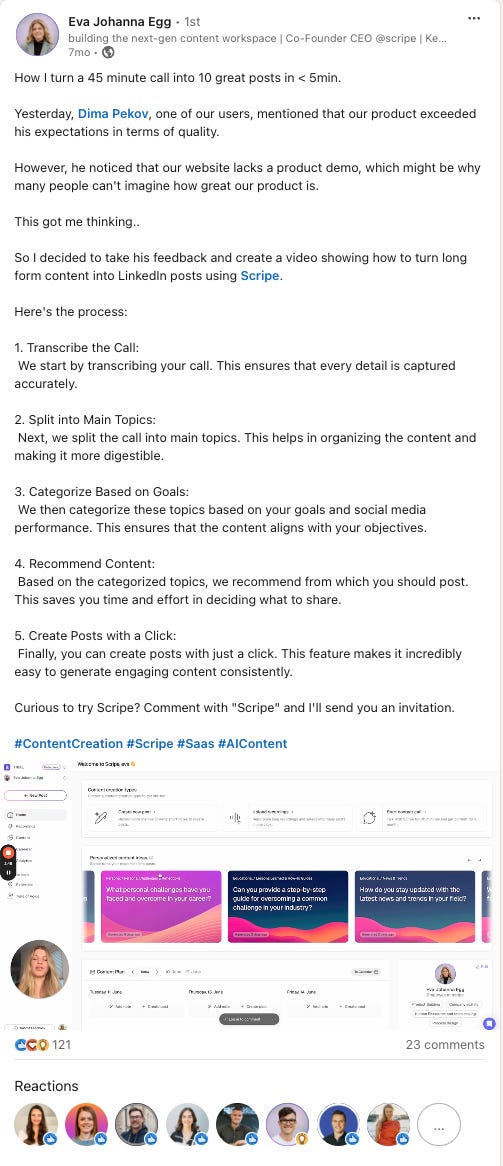

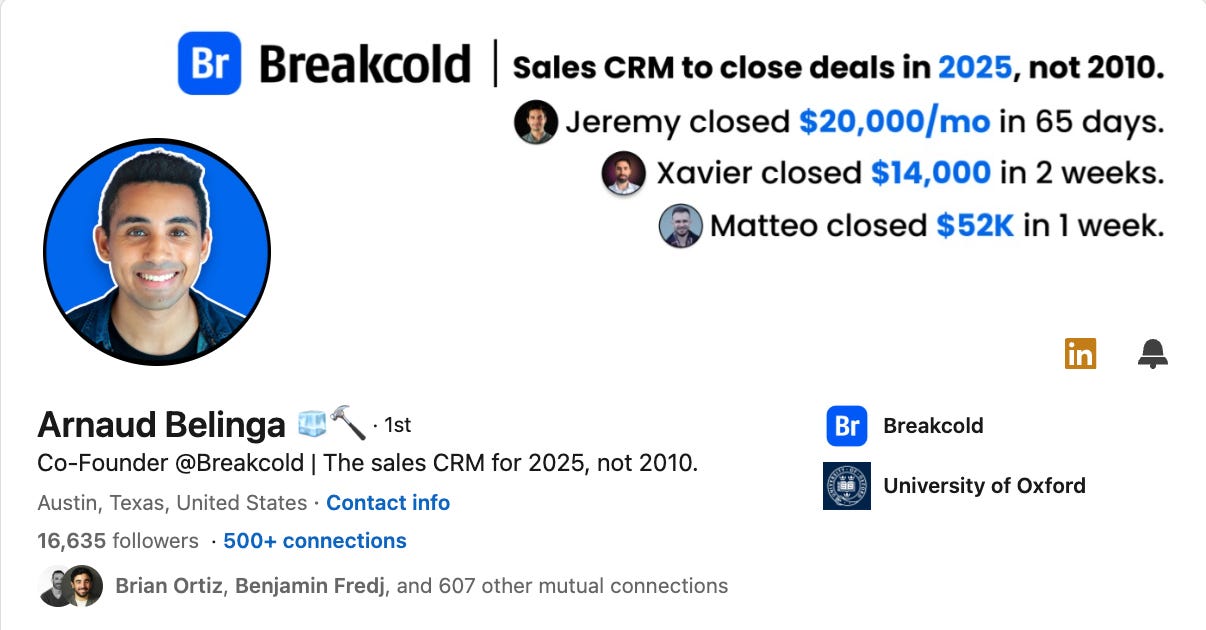

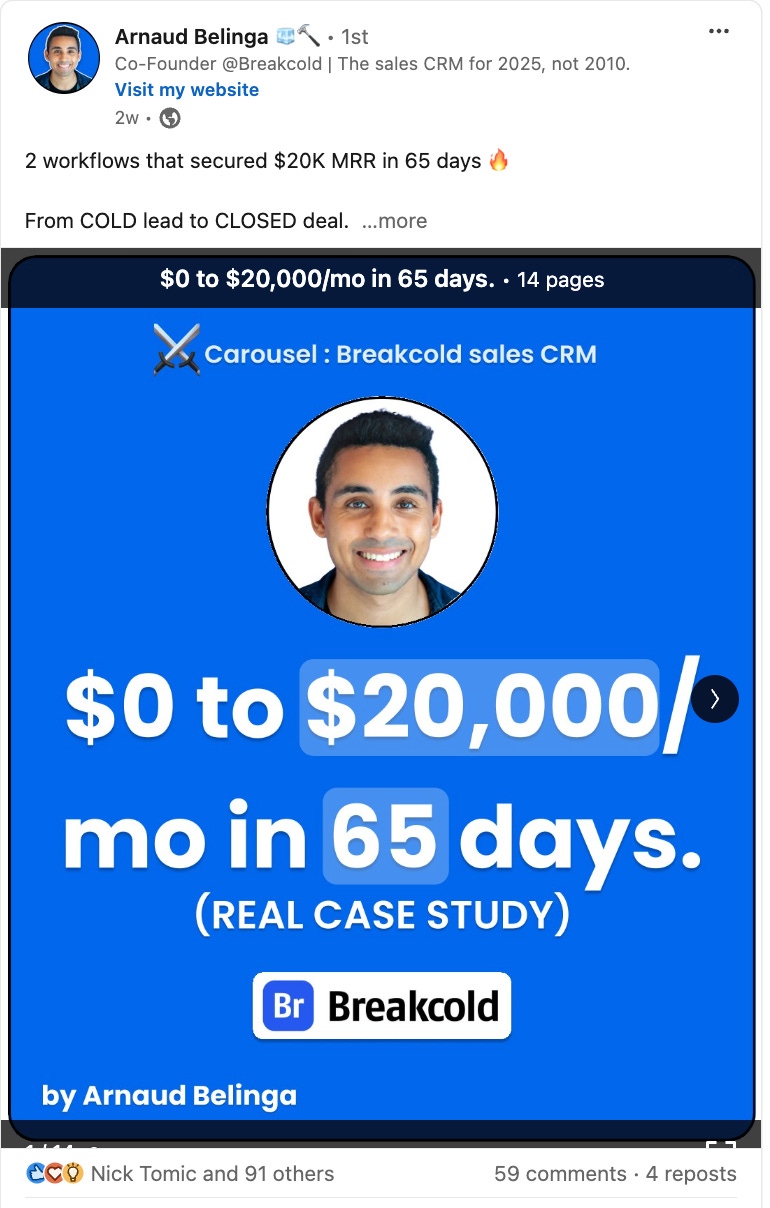
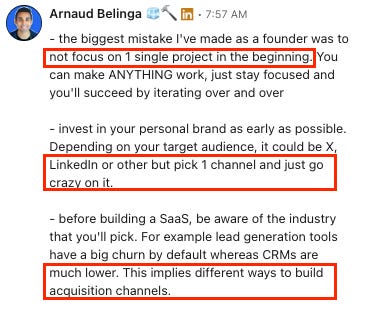

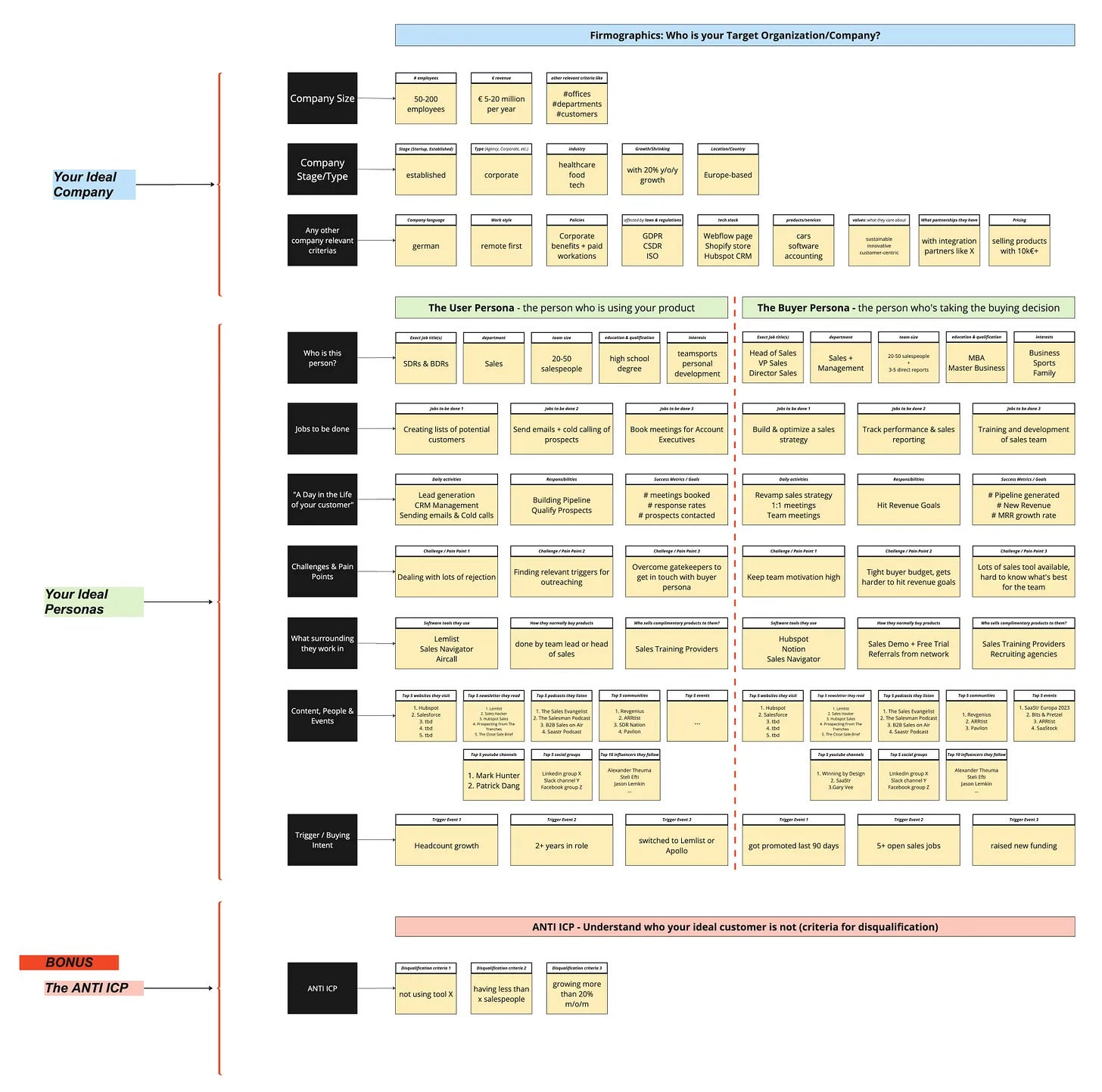









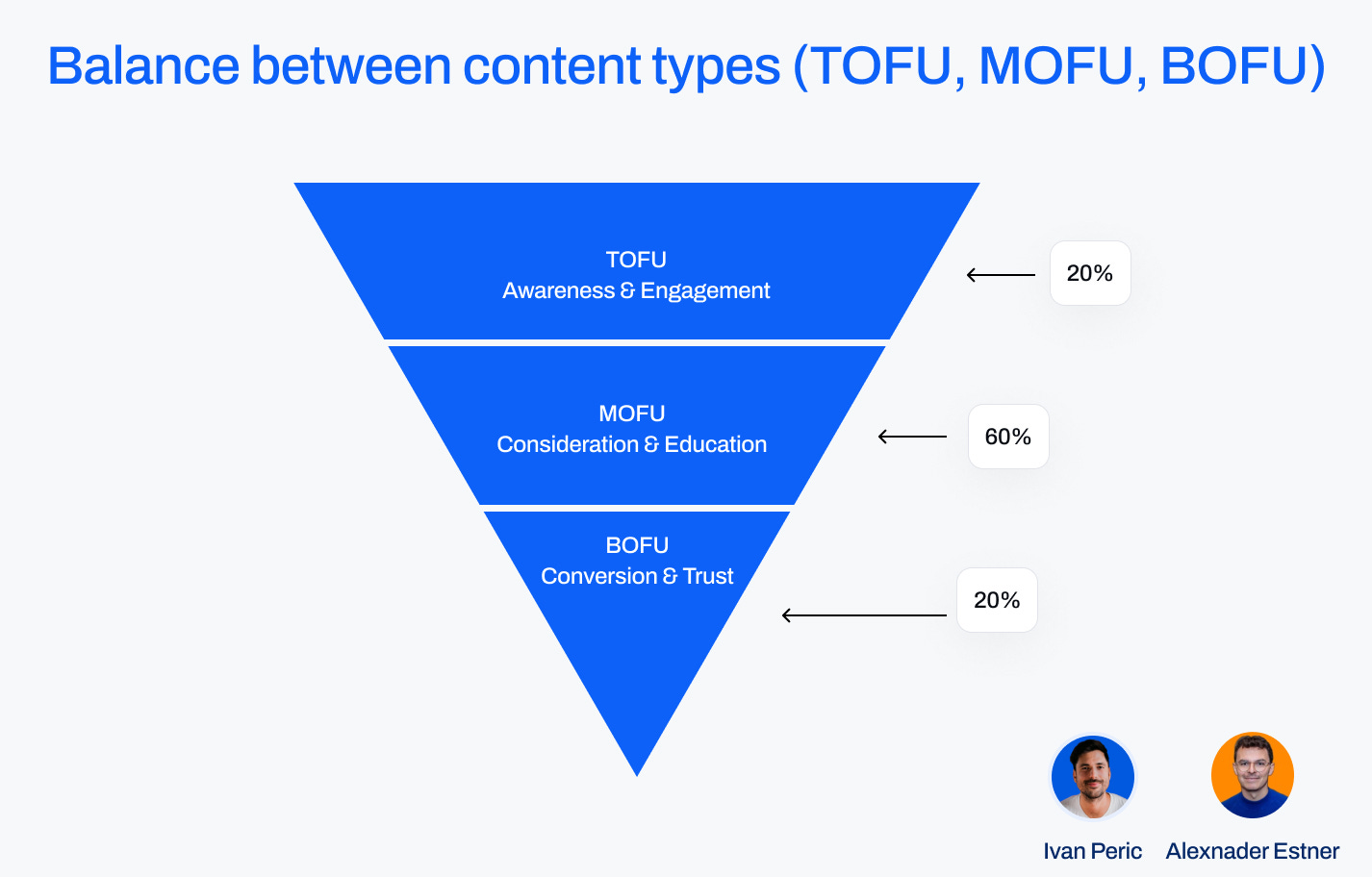










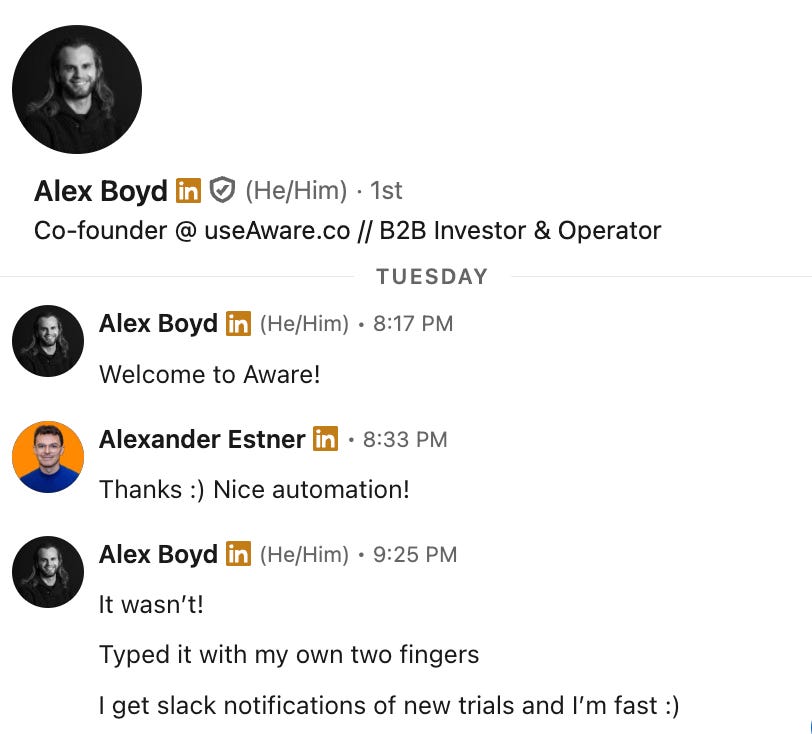





This is spot on. People buy from people, not logos, and that's exactly what founders need to embrace in today's social-first world. i see too many companies focusing on perfecting their company pages, but forgetting the real value lies in human connection.
This is great. If I may, I'd complement it with the fact that all employees are sales-people in one way or the other. Wrote a little guide here https://www.startupriders.com/p/creator-employees-